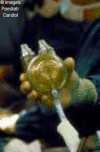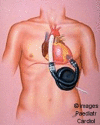Ventricular assist devices in pediatrics
- PMID: 22368605
- PMCID: PMC3232507
Ventricular assist devices in pediatrics
Abstract
The implantation of a mechanical circulatory device for end-stage ventricular failure is a possible therapeutic approach in adult and pediatric cardiac surgery and cardiology. The aim of this article is to present mechanical circulatory assist devices used in infants and children with special emphasis on extracorporeal membrane oxygenation, Berlin Heart assist device, centrifugal pump and Medos assist device. The success of long-term support with implantable ventricular assist devices in adults and children has led to their increasing use as a bridge to transplantation in patients with otherwise non-treatable left ventricular failure, by transforming a terminal phase heart condition into a treatable cardiopathy. Such therapy allows rehabilitation of patients before elective cardiac transplantation (by removing contraindications to transplantation mainly represented by organ impairment) or acting as a bridge to recovery of the native left ventricular function (depending on underlying cardiac disease). Treatment may also involve permanent device implantation when cardiac transplantation is contraindicated. Indications for the implantation of assisted circulation include all states of cardiac failure that are reversible within a variable period of time or that require heart transplantation. This article will address the current status of ventricular assist devices by examining historical aspects of its development, current technical issues and clinical features of pediatric ventricular assist devices, including indications and contraindications for support.
Keywords: Berlin Heart; Centrifugal pump; ECMO; Heart failure; HeartMate; Jarvik 2000; Medos; Thoratec; Ventricular assist device.
Figures










References
-
- Waldenberger FR. Pathophysiological considerations concerning uni- and biventricular mechanical cardiac assist. Int J Artif Org. 1997;20:684–91. - PubMed
-
- Karl TR, Horton SB. Centrifugal pump ventricular assist device in pediatric cardiac surgery. In: Duncan BW, editor. Mechanical support for cardiac and respiratory failure in pediatric patients. New York: Marcel Dekker; 2001. pp. 21–47.
-
- Raithel SC, Pennington DG, Boegner E, Fiore A, Weber TR. Extracorporeal membrane oxygenation in children after cardiac surgery. Circulation. 1992;86:305–10. - PubMed
-
- Herwig V, Severin M, Waldenberger FR, Konertz W. Medos HIA assist system: first experiences with mechanical circulatory assist in infants and children. Int J Artif Org. 1997;20:692–4. - PubMed
-
- Däbritz S, Messmer BJ. Individual center experiences in pediatric machanical circulatory support for bridge-to-transplant and myocardial recovery. In: Hetzer R, Hennig E, Loebe, editors. Mechanical circulatory support. Darmstadt: Springer; 1994. pp. 21–31.
LinkOut - more resources
Full Text Sources
